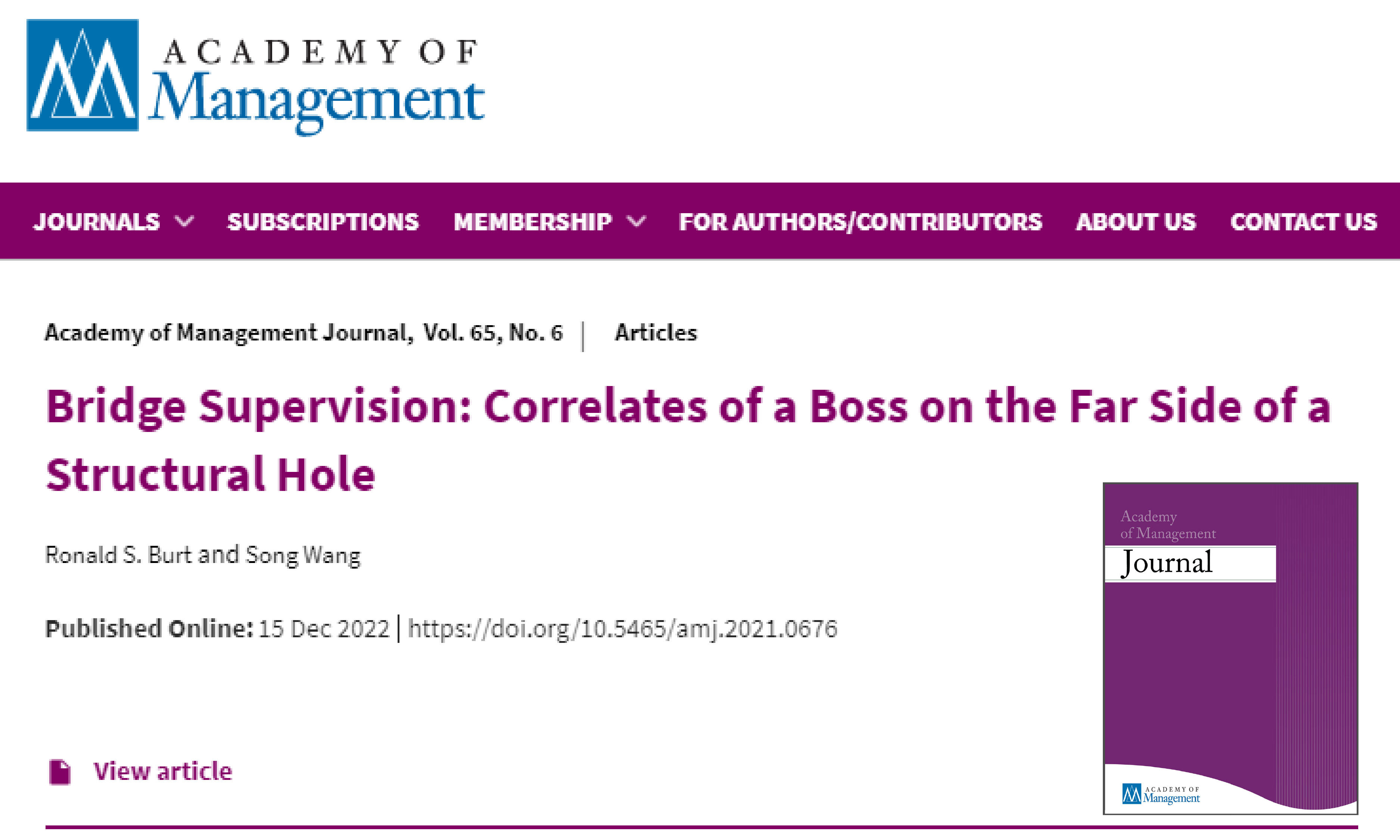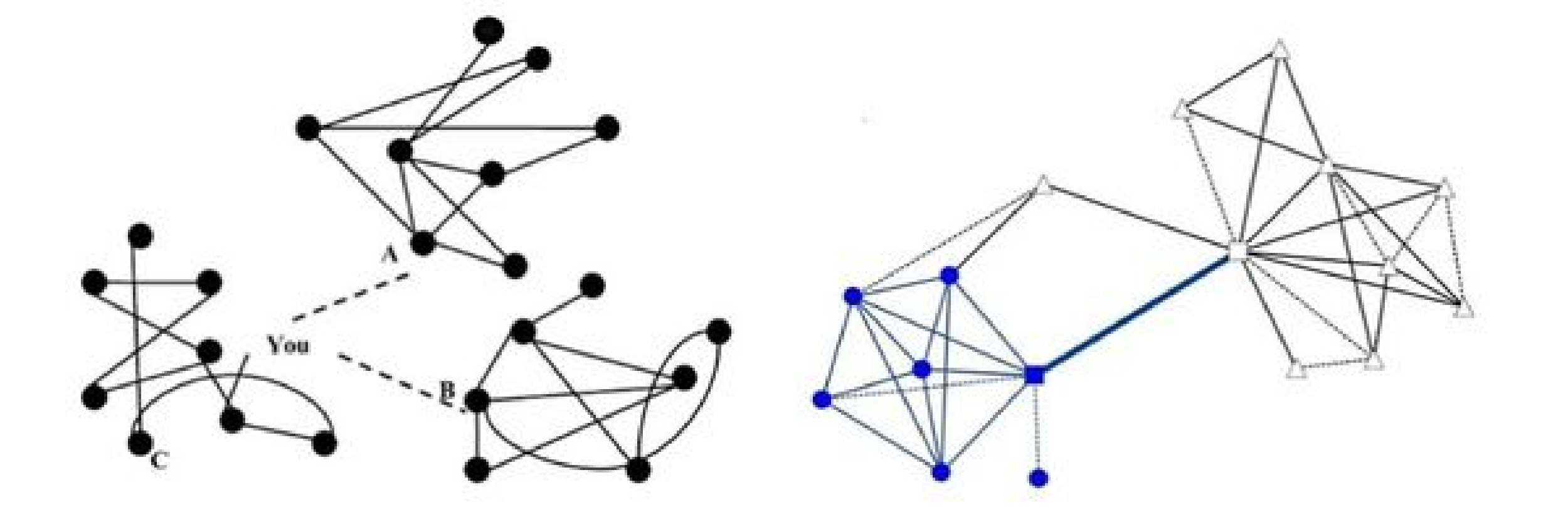
With the development of the digital intelligence economy, platform-based organizations are constantly emerging, the boundaries between teams are becoming more open, online work is on the rise, and individual potential is constantly being stimulated. Management and employee behavior in network-based organizations are currently the focus of academic research.
However, with the rise of the digital office, many have found that the transmission and exchange of information in organizations is often hierarchical. Under normal circumstances, it is difficult for senior managers to communicate directly with subordinates. For example, senior managers transmit information to middle managers via videos, online meetings, etc. This information cannot be heard by other colleagues. At this time, middle managers can serve as "network bridges" to interact vertically and horizontally and convey information to other colleagues in the network.
Recently, Prof. Ronald S. Burt (University of Chicago) and WANG Song, Associate Professor at the Department of Innovation, Entrepreneurship and Strategy, School of Management, Zhejiang University, studied this corporate concept of a single line of communication and innovatively proposed a new organizational network structure - Management Bridge - to further expand and manage enterprises. As a result, they published an academic research “Bridge Supervision: Correlates of A Boss on the Far Side of a Structural Gap” in the Academy of Management Journal.

You can read the original paper here
|
WANG Song | 王颂 School of Management, Zhejiang University |
||
|
|
||
|
|
|
Academic Background: Dr. WANG Song (Ph.D. Peking University) is an associate professor of entrepreneurship and social network in the School of Management, at Zhejiang University. She is a Fulbright visiting student (2011- 2012) at Sloan School of Management, Massachusetts Institute of Technology, and a visiting scholar (2018-2019) in the Stanford Technology and Ventures Program, at Stanford University. Her research interests include social networks and entrepreneurship. You can learn more about Prof. WANG Song’s academic background here |
|
The Team Observed New Changes in Organizational Networks in the Context of Digital Office |
In organizations, managers usually have a "social network" that includes executives, colleagues, subordinates, and other members, and use this network to transmit information, arrange, communicate, and coordinate employees in different departments and levels. Because they are in a "central" position in the organization, they have easier access to information and resources and therefore receive higher salaries and more positive evaluations.
Traditional research on social networks describes managers as the "I" in an organization’s social relationships and focuses on how the "I" uses and manages the social networks between themselves, and network members. For example, managers’ "social networks" enable them to receive and integrate information faster, develop more valuable ideas, and thus get promoted faster.
However, the research group has found that new organizational management models and management issues are constantly emerging in online office scenarios. Traditional structural research usually focuses on the role of personal social relationships and is difficult to characterize the features and governance models of new organizational networks.
Most traditional social network analysis studies examine the "ego network", which focuses on individuals in the organization and focuses on the value of the personal "information broker", or the "overall network", which focuses on the team and focuses on the team as a whole performance research. However, Prof. WANG Song noted that only when we expand the level of research and extend the point-to-point research that focuses on "personal networks" or "overall networks" to the study of networks within networks, can we make more accurate predictions about the characteristics and governance models of new organizational networks. Characterization is also an important and widely used binary network structure feature and an efficiency mechanism that has been ignored in previous studies.
In this context, researchers have described the organizational network structure "management bridge" in this study and clearly defined the definition, configuration, and characteristics of this binary network structure, creating a new paradigm for the research and development of organizational networks.
|
The Team Proposed a New Organizational Structure in the Age of Digital Intelligence |
In this study, the research team, with contributions from WANG Song, focused on the network research of corporate managers, predicted the behavior and performance-related relationships under the network bridge and embedded management, and proposed a new organizational network structure in the context of the digital office - the "management bridge”.
What did their research involve? What were their main conclusions?
01 | The Concept of "Management Bridge"
Researchers have combined the new characteristics of network structure in online organizational scenarios and proposed a new concept of bridge supervision.
In the digital age, online office scenarios have led to the emergence of other new organizational management models and management issues. However, since the structural gap theory was proposed, new concepts and developments in organizational network research have been rare. Therefore, the characteristics and governance models of the new organizational networks have not been described in more detail in previous research.
Based on the structural gap theory, Prof. Ronald S.Burt and Prof. WANG Song have described the network structure of the management bridge and clearly defined the definition, configuration and characteristics of the network structure.
The research shows that the management bridge is a unique organizational network structure: middle managers are the only connecting bridge between superior managers and subordinates, and middle managers and superior managers each have close contact networks that do not overlap each other. In the online office mode, management bridges are common in organizational networks. Middle managers may have a single point of contact with line managers via digital communication media. This contact process and the information they share do not involve other colleagues and subordinates.

Schematic diagram of a structural gap (left) and management bridge (right)
02 | The Impact Mechanism of "Management Bridge" on Work Performance
The research results focus on the management model with the "manager-supervisor" link as the only communication node and explain the mechanism of action of the management bridge network structure on information exchange, emotional expression, and work performance.
Researchers focus on the structural characteristics of the management bridge and the theoretical perspective of manager role isolation, and put forward three major hypotheses.
|
H1 |
The probability of role separation decreases when the number of joint contacts between managers and executives increases. If the frequency of contact between middle managers and higher-level managers increases and the role of managers as information brokers is strengthened, then the intersection between their respective social networks will decrease. |
|
H2 |
The likelihood of role separation occurring increases as the density of relationships between managers’ unique contacts increases. As the density of intermediary managers’ social networks increases, communication between members of the leader network and the manager network also decreases, and the likelihood of their respective social networks overlapping decreases. |
|
H3 |
The performance of the managers is independent of the leadership bridge. The "bridging function" of the intermediate managers is not related to their work performance. |
Subsequently, through a series of empirical studies, WANG Song’s team found that the organizational management model corresponding to the organizational network structure of Management Bridge has the characteristics of low cost and high efficiency. Although it has no direct impact on the performance of managers, in the management bridge structure, intermediate management is the source of information transmission. Supervisors and subordinates cannot communicate directly with each other, so it is easy to create information cocoons between supervisors and subordinates and emotional isolation between supervisors and subordinates.
To avoid the above disadvantages, middle managers must immediately adjust their management style and behavioral tendencies, and constantly improve their communication and management methods, so that information transmission is more complete, resource integration is more efficient, and relations with employees are improved emotionally and behaviorally.
03 | Organizational Network Structure from a Binary Network Perspective
The team focuses on the perspective of dyadic interaction and deconstructs the analytical model of organizational network structure from the perspective of the dyad network. Traditional social network analysis research pays more attention to the influence of managers’ own network structure. In this study, WANG Song’s team included the network of senior managers in addition to the middle managers’ own network.
In this study, the team took the lead in proposing a research path to identify management bridges or other potential new organizational network structures by gaining insights into the characteristics of dyadic networks and promoting the expansion of the research level of organizational networks from self-networks to "leader-manager" meta-network.
|
The Research Focuses on Corporate Social Networks and Provides New Ideas for Corporate Management in the Age of Digital Intelligence |
The research proposed a new organizational structure of Management Bridge, which provides a new methodology for management practice in the digital office environment. Moreover, the weaknesses of Management Bridge were experimentally demonstrated, warning and improving the management style and behavioral tendencies of managers, which enabled managers to improve the efficiency of management and the way of managing people.
01 | Academic Contribution
■ The team proposes a new configuration of the management bridge that provides a conceptual foundation for organizational network research in online network scenarios and supports the iteration and evolution of organizational network research.
■ Compared with traditional organizational network research, this study takes the binary network "manager - leader" as the starting point to condense the structure of the management bridge and provide a conceptual basis for subsequent organizational network research to gain insights into new organizational management models while providing a foundation for organizational network research. The development provides a new paradigm.
■ Explains the path to identifying new configurations of organizational networks.
■ In addition, the study explains the way to identify new configurations of organizational networks and opens new avenues for future research to clarify new organizational management models.
■ This study takes the dyadic network "leader-manager" as a starting point and combines dyadic network analysis to outline a new configuration of the management bridge. In doing so, it offers new research perspectives and methods for subsequent research to identify new configurations of organizational structure in online network scenarios.
02 | Practical Value
■ The research conducted by Prof. Ronald S. Burt and WANG Song provides clues and inspiration for the effective management of employees in online organizational scenarios. The management bridge construct describes the structural characteristics of the new organizational networks in the age of digital intelligence and highlights the central role of middle managers from a theoretical perspective.
■ Research indicates that the organizational structure of the management bridge has the characteristics of low cost and high efficiency and is one of the development trends of the organizational management models of enterprises in the digital age. However, research has also shown that due to the fact that middle managers bear the main responsibility for communication, the organizational structure of the management bridge brings obstacles to information sharing and emotional communication between superior managers and subordinate employees, thus causing middle managers to play a role in information transmission. therefore, more attention should be paid to management methods and procedures in the process of sharing resources, which provides guidance and reference for employee management in online scenarios.
■ Prof. WANG Songs study has contributed to making organizational innovation and management practices in the era of digital economy the subject of research, proposed a new organizational structure for management, and illustrated the bridging function of managers’ organizational networks. For the first time, they focused their research on the dyadic network of corporate managers. And it was proved that the management bridge will influence the emotional expression and management behavior of managers.
|
- The scholars of our School of Management (ZJUSOM) collaborate with researchers from other faculties and universities around the world, contributing to enrich the theory of management knowledge with high-quality scientific research, supporting the development of business management knowledge and providing viable solutions for improving corporate social networks and employee relations management in the age of digital intelligence.
- You can read the original article in Chinese here